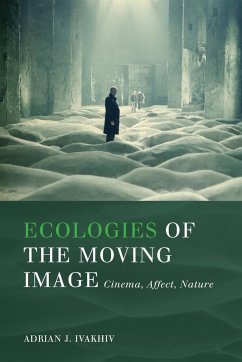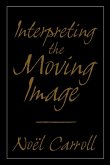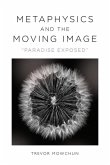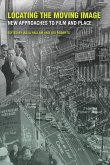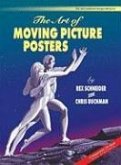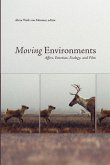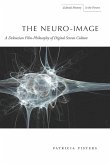- Broschiertes Buch
- Merkliste
- Auf die Merkliste
- Bewerten Bewerten
- Teilen
- Produkt teilen
- Produkterinnerung
- Produkterinnerung
This book presents an ecophilosophy of cinema: an account of the moving image in relation to the lived ecologies - material, social, and perceptual relations - within which movies are produced, consumed, and incorporated into cultural life. If cinema takes us on mental and emotional journeys, the author argues that those journeys that have reshaped our understanding of ourselves, life, and the Earth and universe. A range of styles are examined, from ethnographic and wildlife documentaries, westerns and road movies, sci-fi blockbusters and eco-disaster films to the experimental and art films of…mehr
Andere Kunden interessierten sich auch für
![Interpreting the Moving Image Interpreting the Moving Image]() Noel CarrollInterpreting the Moving Image41,99 €
Noel CarrollInterpreting the Moving Image41,99 €![Metaphysics and the Moving Image Metaphysics and the Moving Image]() Trevor MowchunMetaphysics and the Moving Image30,99 €
Trevor MowchunMetaphysics and the Moving Image30,99 €![Locating the Moving Image Locating the Moving Image]() Julia HallamLocating the Moving Image28,99 €
Julia HallamLocating the Moving Image28,99 €![The Art of Moving Picture Posters The Art of Moving Picture Posters]() Chris BuchmanThe Art of Moving Picture Posters8,49 €
Chris BuchmanThe Art of Moving Picture Posters8,49 €![The Past Is a Moving Picture The Past Is a Moving Picture]() Janna JonesThe Past Is a Moving Picture18,99 €
Janna JonesThe Past Is a Moving Picture18,99 €![Moving Environments Moving Environments]() Alexa Weik Von MossnerMoving Environments47,99 €
Alexa Weik Von MossnerMoving Environments47,99 €![The Neuro-Image The Neuro-Image]() Patricia PistersThe Neuro-Image31,99 €
Patricia PistersThe Neuro-Image31,99 €-
-
-
This book presents an ecophilosophy of cinema: an account of the moving image in relation to the lived ecologies - material, social, and perceptual relations - within which movies are produced, consumed, and incorporated into cultural life. If cinema takes us on mental and emotional journeys, the author argues that those journeys that have reshaped our understanding of ourselves, life, and the Earth and universe. A range of styles are examined, from ethnographic and wildlife documentaries, westerns and road movies, sci-fi blockbusters and eco-disaster films to the experimental and art films of Tarkovsky, Herzog, Malick, and Brakhage, to YouTube's expanding audio-visual universe.
Produktdetails
- Produktdetails
- Verlag: Wilfrid Laurier University Press
- Seitenzahl: 435
- Erscheinungstermin: 25. Juli 2013
- Englisch
- Abmessung: 231mm x 151mm x 30mm
- Gewicht: 621g
- ISBN-13: 9781554589050
- ISBN-10: 1554589053
- Artikelnr.: 36956070
- Herstellerkennzeichnung
- Libri GmbH
- Europaallee 1
- 36244 Bad Hersfeld
- gpsr@libri.de
- Verlag: Wilfrid Laurier University Press
- Seitenzahl: 435
- Erscheinungstermin: 25. Juli 2013
- Englisch
- Abmessung: 231mm x 151mm x 30mm
- Gewicht: 621g
- ISBN-13: 9781554589050
- ISBN-10: 1554589053
- Artikelnr.: 36956070
- Herstellerkennzeichnung
- Libri GmbH
- Europaallee 1
- 36244 Bad Hersfeld
- gpsr@libri.de
Adrian Ivakhiv is a professor of environmental studies at the Rubenstein School of Environment and Natural Resources, University of Vermont, where he coordinates the graduate concentration in Environmental Thought and Culture. He is the author of Claiming Sacred Ground: Pilgrims and Politics at Glastonbury and Sedona (2001), and of numerous articles in geography, environmental studies, film and cultural studies, and religious studies. His blog, Immanence, can be found at http://blog.uvm.edu/aivakhiv/.
Table of Contents for Ecologies of the Moving Image: Cinema
Affect
Nature
by Adrian J. Ivakhiv 1. Preface 2. Acknowledgements 3. 1. Introduction: Journeys into the Zone of Cinema 4. Two perspectives on the visual The cinema as cosmomorphic
or world making: geomorphic
biomorphic
and anthropomorphic Stalker as paradigm: Tracking the cinema
stalking the psyche The argument Overview of the chapters 5. 2. Ecology
Morphology
Semiosis: A Process-Relational Account of Cinema 6. The three ecologies of images: material
social
perceptual Process-relational ontology Perceptual ecologies: How we get drawn into the cinematic world Peircean semiosis: firstness
secondness
and thirdness Spectacle
narrativity
and signness Scenes
episodes
and cinematic impact 7. 3. Territory: The Geomorphology of the Visible 8. Geomorphism in life and in image An initial typology Picturing ""nature"": Landscape aesthetics as socio-natural production Anchoring the filmic world Staking claims and territorializing identities: Making the West Dovzhenko's cinematic pantheism Nature
holism
and the eco-administrative state Industry
existential landscapes
and the firstness of things Post-westerns
pantheism
and the ecological sublime Kinetic landscapes
the exhilaration of movement
and the differentiation of space Cinematic tourism
object fetishism
and the global landscape Enframing the world
or expanding perception? ""Burn but his books"": Deconstructing the gaze from both ends 9. 4. Encounter: First Contact
Utopia
and the Becoming of Another 10. The ethnographic paradigm Nanook/Allakariallak and the two-way gaze King Kong's imperial gaze: From ethnographic to cinematic spectacle Upriver journeys
hearts of darkness
and contact zones Beyond first contact Cinematic holism
auto-ethnography
and visual sovereignty From the deconstruction of reality to its reflexive reconstruction Green identities: images of choice
hope
struggle
and community 11. 5. Anima Moralia: Journeys Across Frontiers 12. Pointing
seeing
gazing Animating the image
imaging the animate Writing
seeing
and faking nature Making nature: inter-natural coproductions Animation
plasmaticness
and Disney Boundary traffic: seeing
being seen
and the horror of crossing over Animal by analogy: penguins and family values Individual crossings: Bittner's birds
Treadwell's bears Sheer becomings: one or several types of packs Boundary strategies: ethics of the contact zone 13. 6. Terra and Trauma: The Geopolitics of the Real 14. Recapitulation of the argument Trauma and the imagination of disaster Strange weather
network narratives
and the traumatic event The sublime and the Real The eco-imaginary in post-9/11 culture Political ecologies in three dimensions and more Avatar's eco-apocalyptic Zone Toward a Peircian synthesis: aesthetics
ethics
and ecologics of the image-event Ecology
time
and the image Ecophilosophical cinema: moving images on a moving planet 15. Afterword: Digital Futures in a Biosemiotic World 16. Appendix: Doing Process-Relational Media Analysis 17. Notes 18. Index
Affect
Nature
by Adrian J. Ivakhiv 1. Preface 2. Acknowledgements 3. 1. Introduction: Journeys into the Zone of Cinema 4. Two perspectives on the visual The cinema as cosmomorphic
or world making: geomorphic
biomorphic
and anthropomorphic Stalker as paradigm: Tracking the cinema
stalking the psyche The argument Overview of the chapters 5. 2. Ecology
Morphology
Semiosis: A Process-Relational Account of Cinema 6. The three ecologies of images: material
social
perceptual Process-relational ontology Perceptual ecologies: How we get drawn into the cinematic world Peircean semiosis: firstness
secondness
and thirdness Spectacle
narrativity
and signness Scenes
episodes
and cinematic impact 7. 3. Territory: The Geomorphology of the Visible 8. Geomorphism in life and in image An initial typology Picturing ""nature"": Landscape aesthetics as socio-natural production Anchoring the filmic world Staking claims and territorializing identities: Making the West Dovzhenko's cinematic pantheism Nature
holism
and the eco-administrative state Industry
existential landscapes
and the firstness of things Post-westerns
pantheism
and the ecological sublime Kinetic landscapes
the exhilaration of movement
and the differentiation of space Cinematic tourism
object fetishism
and the global landscape Enframing the world
or expanding perception? ""Burn but his books"": Deconstructing the gaze from both ends 9. 4. Encounter: First Contact
Utopia
and the Becoming of Another 10. The ethnographic paradigm Nanook/Allakariallak and the two-way gaze King Kong's imperial gaze: From ethnographic to cinematic spectacle Upriver journeys
hearts of darkness
and contact zones Beyond first contact Cinematic holism
auto-ethnography
and visual sovereignty From the deconstruction of reality to its reflexive reconstruction Green identities: images of choice
hope
struggle
and community 11. 5. Anima Moralia: Journeys Across Frontiers 12. Pointing
seeing
gazing Animating the image
imaging the animate Writing
seeing
and faking nature Making nature: inter-natural coproductions Animation
plasmaticness
and Disney Boundary traffic: seeing
being seen
and the horror of crossing over Animal by analogy: penguins and family values Individual crossings: Bittner's birds
Treadwell's bears Sheer becomings: one or several types of packs Boundary strategies: ethics of the contact zone 13. 6. Terra and Trauma: The Geopolitics of the Real 14. Recapitulation of the argument Trauma and the imagination of disaster Strange weather
network narratives
and the traumatic event The sublime and the Real The eco-imaginary in post-9/11 culture Political ecologies in three dimensions and more Avatar's eco-apocalyptic Zone Toward a Peircian synthesis: aesthetics
ethics
and ecologics of the image-event Ecology
time
and the image Ecophilosophical cinema: moving images on a moving planet 15. Afterword: Digital Futures in a Biosemiotic World 16. Appendix: Doing Process-Relational Media Analysis 17. Notes 18. Index
Table of Contents for Ecologies of the Moving Image: Cinema
Affect
Nature
by Adrian J. Ivakhiv 1. Preface 2. Acknowledgements 3. 1. Introduction: Journeys into the Zone of Cinema 4. Two perspectives on the visual The cinema as cosmomorphic
or world making: geomorphic
biomorphic
and anthropomorphic Stalker as paradigm: Tracking the cinema
stalking the psyche The argument Overview of the chapters 5. 2. Ecology
Morphology
Semiosis: A Process-Relational Account of Cinema 6. The three ecologies of images: material
social
perceptual Process-relational ontology Perceptual ecologies: How we get drawn into the cinematic world Peircean semiosis: firstness
secondness
and thirdness Spectacle
narrativity
and signness Scenes
episodes
and cinematic impact 7. 3. Territory: The Geomorphology of the Visible 8. Geomorphism in life and in image An initial typology Picturing ""nature"": Landscape aesthetics as socio-natural production Anchoring the filmic world Staking claims and territorializing identities: Making the West Dovzhenko's cinematic pantheism Nature
holism
and the eco-administrative state Industry
existential landscapes
and the firstness of things Post-westerns
pantheism
and the ecological sublime Kinetic landscapes
the exhilaration of movement
and the differentiation of space Cinematic tourism
object fetishism
and the global landscape Enframing the world
or expanding perception? ""Burn but his books"": Deconstructing the gaze from both ends 9. 4. Encounter: First Contact
Utopia
and the Becoming of Another 10. The ethnographic paradigm Nanook/Allakariallak and the two-way gaze King Kong's imperial gaze: From ethnographic to cinematic spectacle Upriver journeys
hearts of darkness
and contact zones Beyond first contact Cinematic holism
auto-ethnography
and visual sovereignty From the deconstruction of reality to its reflexive reconstruction Green identities: images of choice
hope
struggle
and community 11. 5. Anima Moralia: Journeys Across Frontiers 12. Pointing
seeing
gazing Animating the image
imaging the animate Writing
seeing
and faking nature Making nature: inter-natural coproductions Animation
plasmaticness
and Disney Boundary traffic: seeing
being seen
and the horror of crossing over Animal by analogy: penguins and family values Individual crossings: Bittner's birds
Treadwell's bears Sheer becomings: one or several types of packs Boundary strategies: ethics of the contact zone 13. 6. Terra and Trauma: The Geopolitics of the Real 14. Recapitulation of the argument Trauma and the imagination of disaster Strange weather
network narratives
and the traumatic event The sublime and the Real The eco-imaginary in post-9/11 culture Political ecologies in three dimensions and more Avatar's eco-apocalyptic Zone Toward a Peircian synthesis: aesthetics
ethics
and ecologics of the image-event Ecology
time
and the image Ecophilosophical cinema: moving images on a moving planet 15. Afterword: Digital Futures in a Biosemiotic World 16. Appendix: Doing Process-Relational Media Analysis 17. Notes 18. Index
Affect
Nature
by Adrian J. Ivakhiv 1. Preface 2. Acknowledgements 3. 1. Introduction: Journeys into the Zone of Cinema 4. Two perspectives on the visual The cinema as cosmomorphic
or world making: geomorphic
biomorphic
and anthropomorphic Stalker as paradigm: Tracking the cinema
stalking the psyche The argument Overview of the chapters 5. 2. Ecology
Morphology
Semiosis: A Process-Relational Account of Cinema 6. The three ecologies of images: material
social
perceptual Process-relational ontology Perceptual ecologies: How we get drawn into the cinematic world Peircean semiosis: firstness
secondness
and thirdness Spectacle
narrativity
and signness Scenes
episodes
and cinematic impact 7. 3. Territory: The Geomorphology of the Visible 8. Geomorphism in life and in image An initial typology Picturing ""nature"": Landscape aesthetics as socio-natural production Anchoring the filmic world Staking claims and territorializing identities: Making the West Dovzhenko's cinematic pantheism Nature
holism
and the eco-administrative state Industry
existential landscapes
and the firstness of things Post-westerns
pantheism
and the ecological sublime Kinetic landscapes
the exhilaration of movement
and the differentiation of space Cinematic tourism
object fetishism
and the global landscape Enframing the world
or expanding perception? ""Burn but his books"": Deconstructing the gaze from both ends 9. 4. Encounter: First Contact
Utopia
and the Becoming of Another 10. The ethnographic paradigm Nanook/Allakariallak and the two-way gaze King Kong's imperial gaze: From ethnographic to cinematic spectacle Upriver journeys
hearts of darkness
and contact zones Beyond first contact Cinematic holism
auto-ethnography
and visual sovereignty From the deconstruction of reality to its reflexive reconstruction Green identities: images of choice
hope
struggle
and community 11. 5. Anima Moralia: Journeys Across Frontiers 12. Pointing
seeing
gazing Animating the image
imaging the animate Writing
seeing
and faking nature Making nature: inter-natural coproductions Animation
plasmaticness
and Disney Boundary traffic: seeing
being seen
and the horror of crossing over Animal by analogy: penguins and family values Individual crossings: Bittner's birds
Treadwell's bears Sheer becomings: one or several types of packs Boundary strategies: ethics of the contact zone 13. 6. Terra and Trauma: The Geopolitics of the Real 14. Recapitulation of the argument Trauma and the imagination of disaster Strange weather
network narratives
and the traumatic event The sublime and the Real The eco-imaginary in post-9/11 culture Political ecologies in three dimensions and more Avatar's eco-apocalyptic Zone Toward a Peircian synthesis: aesthetics
ethics
and ecologics of the image-event Ecology
time
and the image Ecophilosophical cinema: moving images on a moving planet 15. Afterword: Digital Futures in a Biosemiotic World 16. Appendix: Doing Process-Relational Media Analysis 17. Notes 18. Index

